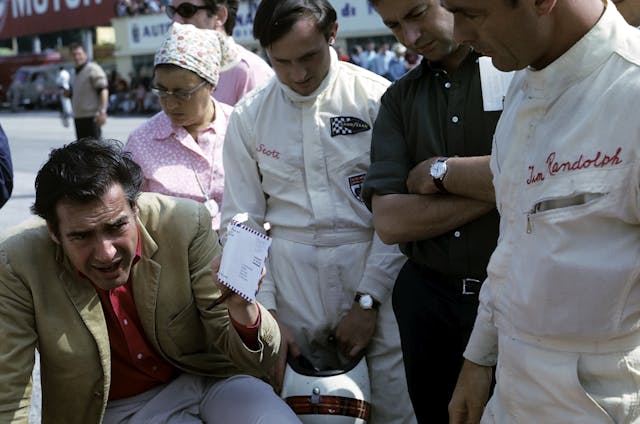As Frankenheimer proved, you have to strap a camera on it
Years ago, I was standing on the back porch of Brock Yates’s house in upstate New York when a lanky, distinguished-looking fellow slid open the screen door, strode up to me, and introduced himself. As he glided away, I turned to my coworker and silently mouthed the words, “The John Frankenheimer?” Later, after we all settled into Brock’s boat for a cruise up the Saint Lawrence, a few of us began needling the famous director for details about filming the best racing movie ever made, Grand Prix.
Frankenheimer recounted how he was spurned by a skeptical Enzo Ferrari until the director showed him some raw footage from the opening scenes at Monaco. When the lights came on, Enzo got up, marched over to Frankenheimer, and hugged him, saying, “You. You understand!” The price for Ferrari’s involvement was a hasty rewrite of the film’s ending. Ferrari’s leading driver was to be killed at Monza, with its second driver finishing down the ranks, thus allowing James Garner as Pete Aron to win the championship. Enzo complained that the Scuderia shouldn’t have to both lose a driver and suffer the ignominy of defeat, so Enzo came up with the idea of humanely withdrawing the second Ferrari from the race.

Frankenheimer told us about the endless problems they had with the hydrogen cannon that fired Garner’s BRM into the Monaco harbor. He claimed that the sequence in which a loose pipe falls off a car and tumbles down the Monza banking and fatally under Yves Montand’s Ferrari was accomplished in one very lucky take. And Frankenheimer grumbled that he killed the wrong man, that he should have instead killed off Garner, an actor who was legendarily prickly on set.
Yes, Eva Marie Saint is a melodramatic disaster, and the plot of this 1966 epic is contorted, but it seems unlikely that anyone will ever top it. Others have tried, the best efforts lately being Ron Howard’s Rush, about the relationship between Niki Lauda and James Hunt, and 2019’s Ford v Ferrari. Both are enjoyable enough but also rife with technical and historical errors and hyperbolic cinematography. In Rush, the camera shakes violently, as if every car on the 1976 F1 grid had wheel-balance problems. Aside from the unforgivable character assassination of Leo Beebe, Ford v Ferrari suffers silly race-flick tropes like drivers locking eyes and pressing down to go faster when they’re already at flank speed.

Which brings us to the real reason Grand Prix and Frankenheimer’s 1998 action spectacular, Ronin, with its electrifying chase sequences, may never be beaten: George Lucas. After directing American Graffiti, his ode to small-town cruise culture brilliantly set to a nonstop soundtrack of period pop standards as heard through a tinny AM car radio, Lucas made Star Wars. In doing so, he became dissatisfied with contemporary film technology and embraced computer-generated imagery (CGI). It helped make him a billionaire but also, frankly, destroyed the movies.
Far too often, flashy digital cartoonery stands in for plot and dialogue. Cars, buildings, whole worlds blow up on cue as the humans utter canned lines in front of green screens. Lucas himself produced a string of stinkers before selling out to Disney, proving that, like Darth Vader, he was destroyed—at least creatively—by a powerful force he couldn’t control.

Freed from the dictates of physics, directors now offer us leaping, supersonic, indestructible digi-cars. Yawn. To really film a car properly, you have to strap a camera on it (or on one next to it) and go like hell. That’s how Frankenheimer did it. That’s how Steve McQueen did it in Bullitt and Le Mans. That’s how George Miller thrillingly shot the original Mad Max and how director James Mangold filmed at least parts of Ford v Ferrari.
Frankenheimer’s passing in 2002 coincided with the rise of CGI. As the tech improves and becomes harder to distinguish from reality, all we can hope is that more directors will finally figure out how to balance it with story and live action in more good car flicks.



Ridiculous. The lengths people will go to in order to insult Lucas. He worked as a cameraman on Grand Prix. He has a deep love for motorsports and racing on film. He has chase sequences in multiple films. Ford v Ferrari has a lot of cgi too. Grow up.